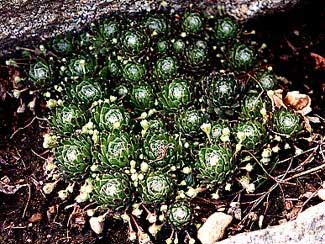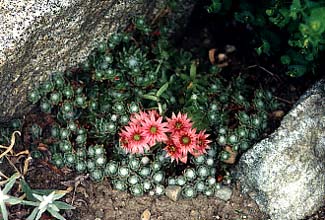 Cobweb Houseleek
Cobweb Houseleek
"Of all the Houseleeks neatest far
The jolly Cobweb Houseleeks are."
-Walter Ingwersen,
1943
1943
The usual "hen & chicks" has a big central hen with lots of youngsters gathered round, but Sempervivum arachnoideum var tomentosum coll. Sion tends to be made up of one-inch balls all about equal in size, with no mother hen. Hence the preferred common name is Houseleek, & for this one in particular, Cobweb Houseleek because it develops a fine cocooning fuzz over its surface that resembles cobwebbing. S. arachnoideum has many cultivars & some have the cobweb feature in the extreme, others just a very slight cocooning.
This strain of the European species originated in the Pyrenees to the Carpathians where many variations occur naturally. Besides very furry or slightly furry, there are types that are red, some maroon, others green. Some form clusters of one-inch balls, others have larger balls. There is even a dwarf form, & they all hybridize easily for new varieties.
 They are typically sold amidst "mixed hens & chicks" & there'll be no way to detect the precise cultivated form because there are too many, but the light fuzziness & tendency for the balls to become all the same size makes the species generally easy to recognize.
They are typically sold amidst "mixed hens & chicks" & there'll be no way to detect the precise cultivated form because there are too many, but the light fuzziness & tendency for the balls to become all the same size makes the species generally easy to recognize.Houseleek has pink to white blooms on thick four inch tall stalks in summer, lasting into early autumn. The second photo, taken in July (2003), shows the bloom, though from an angle that forshortened the stalk so you can't really tell the blooms hover four inches above the plant. The blooms last & last.
Cobweb houseleek takes little water & could rot if watered too often. In the Northwest it tolerates shade, but a sunny spot is nicest, though in warmer climates it needs protection from too much sun because it is not very heat tolerant.
It will spread itself through narrow locations between rockery stones. It does not prefer rich loamy soil; gritty dirt with pea gravel suits it. It is adaptable however & ours grows in a raised well-drained area of the rockery in the same loamy soil prepared for the garden at large, & has never shown signs of unhappiness. Occasionally I have been very slow to get round to clearing fallen leaves off of it in autumn, so that it is completely covered, & though this is certainly not good for it, I've yet to see signs of it being harmed.